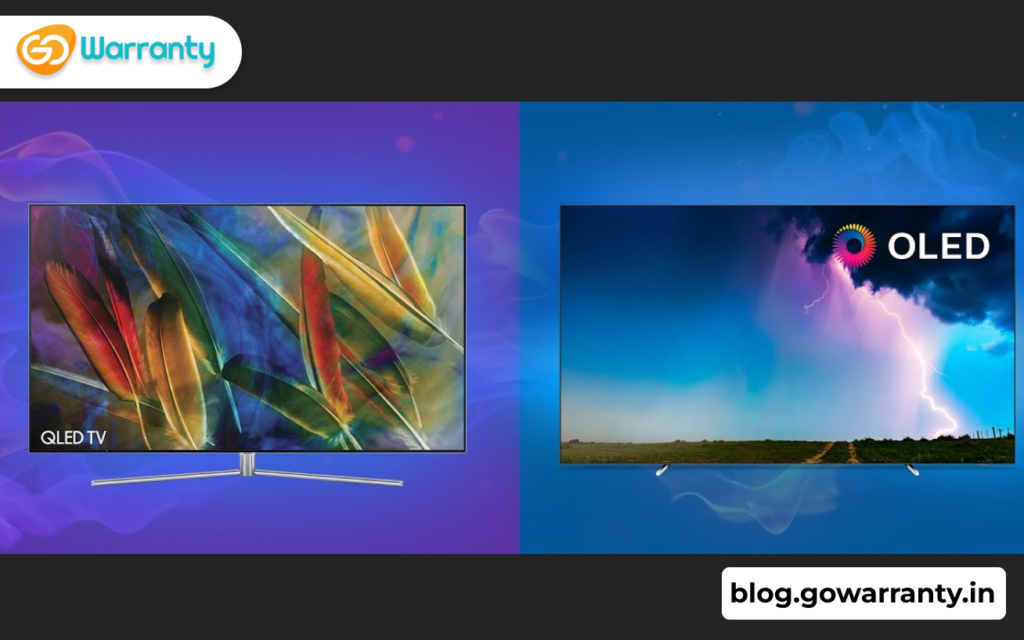If you’ve been looking for a new TV, you’ve probably come across two acronyms that stand out when it comes to TV types: QLED and OLED. While newer TV technology, such as Samsung’s QD-OLED has recently gained attention, QLED and OLED TVs still rule. But what’s the difference between the two?
Companies such as Samsung, TCL, and Hisense boast about the incredible brightness of their QLED TVs, whereas LG, Sony, Panasonic, and others boast about the outstanding contrast and black levels of their OLED TVs.
What is QLED?
QLED is an abbreviation for Quantum Light-Emitting Diode. In layman’s terms, this means that a QLED TV is similar to a regular LED TV, except that it uses tiny nanoparticles called quantum dots to boost brightness and colour. However, so-called “white” LEDs tend to stray into the blue, red, or green parts of the spectrum.
When a TV’s colour filter receives less than full-spectrum white light, it cannot do its job accurately (showing you the colours you’re supposed to see). The backlight source in a QLED TV is composed of a layer of blue LEDs overlaid with a layer of red and green quantum dots. These quantum dots can be precisely combined to produce a near-perfect, full-spectrum white light without sacrificing a single nit of brightness. That perfect white light is precisely what the TV’s colour filter requires in order to generate an accurate palette of billions of colours seen on a TV screen.
What is OLED?
OLED is an acronym that stands for Organic Light-Emitting Diode. Surprisingly, the “Light Emitting-Diode” component of the name has nothing to do with an LED backlight. Instead, it refers to the fact that every single pixel in an OLED panel is a teeny-tiny LED light, however one that is incredibly thin and capable of producing both light and colour in a single element. In other words, because each OLED pixel produces its own light, OLED TVs do not require a backlight. If you want to impress your friends, you can refer to these types of displays as emissive or self-emissive.
There are several benefits to this design, but most people would agree that the best advantage for OLED TVs is the superb black level that can be achieved. Unlike a QLED or LED TV, which must dim its backlight as well as block the remaining light for dark or pitch-black scenes, an OLED TV basically turns off the pixels that comprise the screen’s dark areas.
What is a Mini-LED?
As you research your new TV options, you may come across some that tout mini-LED technology. It may appear to be a competitor to QLED and OLED, but it is simply an enhancement to the LED backlighting used in QLED and LED TVs.
Mini-LEDs are much smaller than regular LEDs. This means that a QLED TV that could previously hold hundreds of LEDs can now hold tens of thousands of mini-LEDs. The end result? Significantly more control over backlighting, resulting in black levels that are far more similar to OLED than any non-OLED display has ever achieved.
QLED Vs OLED: Comparison
Black Levels and Contrast
The contrast of an image is the difference between its darkest and brightest areas. If a TV can deliver a truly black dark portion, the bright parts don’t have to be as bright to achieve good levels of contrast. Due to its ability to go completely black when necessary, OLED is the undisputed champion when it comes to black levels.

Brightness
When it comes to brightness, QLED TVs have a significant advantage. These LED backlights can be made incredibly achingly bright, more than bright enough to be seen clearly in even the brightest lit rooms — because they use separate backlights (rather than relying on each pixel to create its own light). On a pure brightness basis, OLED panels cannot compete and QLED wins this.
Colour Space
According to Samsung, the use of quantum dots in QLED TVs has allowed it to inch forward in terms of colour accuracy, colour brightness, and colour volume, which claims that a wider range of better-saturated colours at extreme brightness levels is an advantage. While there is no denying that these quantum dot TVs produce fantastic colours, so it’s a draw.
Viewing Angle
The best viewing angle for QLED screens is dead centre, and the picture quality decreases in brightness, colour, and contrast as you move side to side or up and down. While the severity varies by model, it is always noticeable regardless of TV manufacturers’ best efforts to eliminate the problem. In comparison, OLED screens can be viewed with no luminance degradation even at extreme viewing angles of up to 84 degrees, so the winner is OLED.
Size
OLEDs have improved significantly. OLED screens had a maximum size of 55 inches when the technology was still in its early stages. OLED TVs as large as 97 inches and QLED TVs as large as 98 inches are now available. OLED remains more expensive as screen sizes increase, but QLED no longer has a monopoly on extra-large displays. Hence, it’s a draw.
Life-Span
LG claims that watching its OLED TVs five hours per day for 54 years would result in them losing 50% of their brightness. That remains to be seen, as OLED TVs have only been on the market since 2013. QLED is even more recent, but it’s backlighting source LED has a long and proven track record and so the winner for now is QLED.
Price
Previously, QLED TVs would have easily won this category, but OLED TVs have come down in price, and since we’re talking all-premium here, comparable QLED TVs cost about the same. This year (2023) will see the highest number of OLED-based TVs produced to date, and as is always the case, as production numbers increase, prices fall. LG’s largest 88-inch OLED TV was INR 24,60,00 in 2021. In 2022, its larger, 97-inch model will be less expensive (INR 20,50,000). Our winner is still QLED because it is more affordable per inch of screen size, but the gap is getting smaller year by year.

